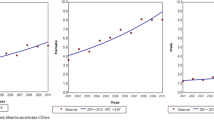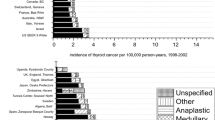Abstract
A total of 154 cases of thyroid cancer in children under 15 were registered in England and Wales over a period of 30 years, an incidence of about 0.5 per million per year. A total of 4.5 cases per year were registered in 1963-72, 4.9 in 1973-82 and 5.8 in 1983-92. A rapid rise in incidence with age occurred after the age of 5. Malignancy was confirmed in 92% of the cases in which tissue was available. Of these, 68% were papillary carcinomas, 11% follicular carcinomas and 17% medullary carcinomas. There were two spindle cell tumours with mucous cysts and one teratoma. The increased frequency but small size of medullary carcinomas in the second half of the period suggested that this increase was due to the introduction of screening; it accounted for most of the rise in crude incidence rats with time. The sex ratio (F:M) in all registered cases in the differentiated follicular cell carcinoma groups in children aged under 10 was 1.2:1, and 3.6:1 in the older children. Five children with differentiated thyroid cancer of follicular cell origin died up to 17 years after diagnosis. Two of the eight children aged 9 or less with a 20 year follow-up died, compared with three of 28 older children. An unusual group of differentiated carcinomas showed solid or follicular architecture. These tumours were unencapsulated, often widely invasive, contained psammoma bodies but little or no papillary architecture and the nuclei often lacked prominent grooving. This childhood type of papillary carcinoma contrasted with the classical type commonly found in the adult, which was present in one of 13 confirmed papillary carcinomas in children aged less than 10, compared with 20 of 35 older children. These observations show that thyroid carcinoma in very young children has a different spectrum of histological types from both older children and adults. From the age of about 10 well-differentiated papillary carcinomas rapidly increase in frequency in females, so that the other types come to form only a small proportion of the total. These differences, and the lower incidence but poorer prognosis of thyroid carcinoma in men and the poorer prognosis in post- as compared with premenopausal women, are compatible with a major role for sex hormones in thyroid carcinogenesis in females during the reproductive period. This study documents the incidence of childhood thyroid cancer in England and Wales, explains the rise in crude incidence rates, shows differences between carcinomas in children under and over the age of ten which may correlate with puberty, and draws attention to an unusual aggressive type of childhood papillary carcinoma. It illustrates the value to crude registry data of a pathology review.
Similar content being viewed by others
Author information
Authors and Affiliations
Rights and permissions
About this article
Cite this article
Harach, H., Williams, E. Childhood thyroid cancer in England and Wales. Br J Cancer 72, 777–783 (1995). https://doi.org/10.1038/bjc.1995.410
Issue Date:
DOI: https://doi.org/10.1038/bjc.1995.410
- Springer Nature Limited
This article is cited by
-
Diagnostic performance of the 2021 Korean thyroid imaging reporting and data system in pediatric thyroid nodules
European Radiology (2022)
-
Frequent BRAF V600E and Absence of TERT Promoter Mutations Characterize Sporadic Pediatric Papillary Thyroid Carcinomas in Japan
Endocrine Pathology (2017)
-
Pediatric papillary thyroid carcinoma: outcomes and survival predictors in 2504 surgical patients
Pediatric Surgery International (2016)
-
Thyroid carcinoma in children, adolescents and adults, both spontaneous and after childhood radiation exposure
European Journal of Pediatrics (2016)




